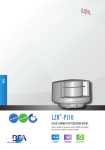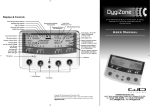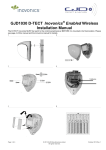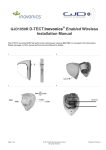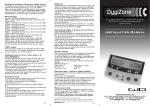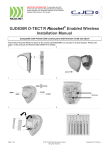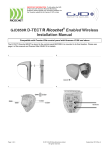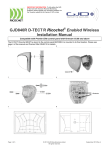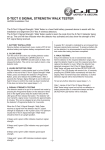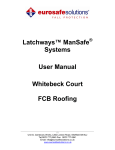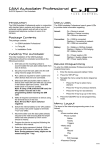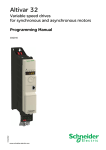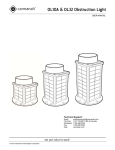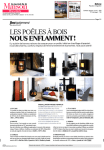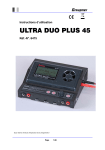Download GJD505 & GJD509 USER GUIDE
Transcript
EN USER GUIDE GJD505 & GJD509 GJD505 & GJD509 LASER SCANNERS FOR INDUSTRIAL DOORS & OTHER SAFETY AND PROTECTION APPLICATIONS GJD509: max. detection range of 10 m x 10 m GJD505: max. detection range of 5.0 m x 5.0 m 1 SAFETY The device contains IR and visible laser diodes. IR laser: wavelength 905nm; max. output pulse power 75W (Class 1 according to IEC 60825-1) Visible laser: wavelength 650nm; max. output CW power 3mW (Class 3R according to IEC 60825-1) The visible laser beams are inactive during normal functioning. The installer can activate the visible lasers if needed. CAUTION! Use of controls, adjustments or performance of procedures other than those specified herein may result in hazardous radiation exposure. Do not look into the laser emitter or the visible red laser beams. The warranty is void if unauthorized repairs are made or attempted by unauthorized personnel. Only trained and qualified personnel may install and adjust the sensor. Test the good functioning of the installation before leaving the premises. When used in conjunction with industrial doors the manufacturer of the door system is responsible for carrying out a risk assessment and installing the sensor and the door system in compliance with the applicable national and international regulations and standards on door safety and, if applicable, the machinery directive 2006/42/EC. Other use of the device is outside the permitted purpose and cannot be guaranteed by the manufacturer. The manufacturer cannot be held responsible for incorrect installations or inappropriate adjustments of the sensor. INSTALLATION AND MAINTENANCE Avoid extreme vibrations. Do not cover the front screens. Avoid exposure to Avoid direct exposure sudden and extreme to high pressure temperature changes. cleaning. 2 Avoid moving objects and light sources in the detection field. Avoid the presence of smoke and fog in the detection field. Avoid condensation. Do not use aggressive products to clean the front screens. Wipe the front screens regularly with a clean and damp cloth. Keep the sensor permanently powered in environments where the temperature can descend below -10°C. DESCRIPTION 1 2 3 4 5 7 8 6 9 10 1. 2. 3. 4. 5. laser sweep emission laser sweep reception LED-signal (4) screw for position lock (2) connector 6. 7. 8. 9. 10. protection cover visible laser beam (3) notch for tilt angle adjustment (2) adjustable bracket cable conduit (4) LED-SIGNAL 1 3 2 4 1. 2. 3. 4. Detection LED: relay 1 - optional field Detection LED: relay 2 - safety field Error LED Power LED LED flashes quickly LED flashes ERROR LED POWER LED detection error power no detection no error no power DETECTION LEDs TIP! LED flashes slowly LED is off All LEDs can be switched off and on again by remote control: SYMBOLS CAT 2 CAT 2 Not According according to to Caution! Laser radiation Remote control sequence Possible remote control adjustments Factory values EN ISO 13849-1:2008 Pl «d» / CAT2 3 1 MOUNTING 1 Use the adhesive mounting template to position the sensor correctly. The grey area indicates the detection range. 4 Position the bracket and fasten the 4 screws firmly in order to avoid vibrations. 7 Position the housing on the bracket. 4 2 Drill 4 holes as indicated on the mounting template. Make a hole for the cable if possible. 5 Open the protection cover, plug the connector and position the cable in the slit. 8 Turn the sensor until the two triangles are face to face. 3 10 cm Pass the cable +/- 10 cm though the cable opening. If drilling an opening is not possible, use the cable conduits on the back side of the bracket. 6 Close the protection cover and fasten it firmly. 2 WIRING GREEN POWER SUPPLY + POWER SUPPLY - BROWN WHITE RELAY 1 - OPTIONAL FIELD YELLOW PINK RELAY 2 - SAFETY FIELD VIOLET RED TEST + TEST - BLUE WHITE/RED NOT USED WHITE/BLUE 3 TO oor ENABLED control without test: connect red and blue wires to power supply (no polarity) POSITIONING Unlock the sensor and activate the visible laser beams. The visible laser beams indicate approximately the postion of curtain C1 and limit the angle of the detection field. C1 C2 C3 C4 The visible laser beams stay activated for 15 minutes or can be turned off the same way they were activated. 1 2 Adjust the lateral position of the detection field. CAT 2 Adjust the tilt angle of the detection field with the hex key. 3 Lock the position of the mounting bracket to avoid malfunctioning in case of extreme vibrations. CAUTION! The distance between the inner curtains of the 2 sensors must be max. 20 cm. 5 4 MOUNTING SIDE Stay outside of the detection field to avoid disturbances. Select the corresponding mounting side. The sensor learns its environment and automatically determines the detection field(s). Both RED LEDs flash slowly and the 3 visible laser beams automatically light up during 30 seconds. CAT 2 CAT 2 left 5 right left right centre WITH BACKGROUND WITHOUT BACKGROUND The sensor memorizes the floor as reference point and signals a fault when its orientation is changed. No reference point, no signal. SAFETY FIELD DIMENSIONS LZR® -I110 GJDR® -I100 MAX MIN WIDTH no field 0.5 m MAX MIN 9.9 m no field 0.5 m 5.0 m 5.0 m HEIGHT 0.5 m 9.9 m 0.5 m 5.0 m 5.0 m EXAMPLE for a field width of 6.2 m IMPORTANT: Test the good functioning of the installation before leaving the premises. TEACH-IN Launch a teach-in after changing the sensor position or when new objects are added to or changed in the detection zone. The detection field should be free of snow buildups, heavy rain, snowfall, fog or other moving objects. Wait for the sensor to learn its environment or lock it by remote control. 3s max. 30 s During teach-in, the sensor learns its surroundings and adapts the detection field shape to these. Objects in the detection field will be cut out. 6 REMOTE CONTROL ADJUSTMENTS (OPTIONAL) DETECTION CURTAINS CURTAIN X X X X C1 C2 C3 C4 EX: C1 + C2 active on optional field only C3 + C4 active on safety field only deactivate curtain on both fields C1 active on both fields C2+C3 active on safety field only C4 deactivated activate curtain only on optional field activate curtain only on safety field C1 C2 C3 C4 activate curtain on both fields All curtains active on both fields The distances between the curtains depend on the mounting height and side. When mounted on the left, the distance between the first and the last curtain is approximately 10 cm for every meter (mounting height). Example: at 5 m the distance is 50 cm. UNCOVERED ZONE 5 10 15 CAT 2 25 20 cm CAT 2 Increase in case of snow, dead leaves, etc. IMMUNITY FILTER indoor outdoor outdoor indoor outdoor high med low outdoor outdoor outdoor high low med CAT 2 CAT 2 CAT 2 Increased immunity to rain, snow, fog... CAT 2 Increased sensitive (detection of black objects, ...) MIN. OBJECT SIZE (approximate values) 5 off 10 20 15 cm CAT 2 CAT 2 OUTPUT ACTIVATION DELAY (approximate values) off 100 200 300 The outputs are triggered after a constant detection time of x ms (ex. value 3= 300 ms). DETECTION FIELD REDIRECTION R1 R2 optional optional or safety safety safety 400 500 600 700 800 900 ms OUTPUT CONFIGURATION R1 R2 FACTORY VALUES R1 A - NO P - NC P - NC A - NO A = active P = passive R2 P - NC A - NO P - NC A - NO NO = normally open NC = normally closed Rx = RELAY OUTPUT 7 OPTIONAL FIELD CONFIGURATIONS Make sure the white and yellow wires are connected to the corresponding inputs before you choose one of the following two configurations. VIRTUAL PUSH BUTTON FOR INDUSTRIAL DOORS Install 1 or 2 virtual push buttons as activation zone(s) to open the door «manually». 1 Apply the vitual push button sticker(s) within the opening field. 2 Launch a PB teach-in to configure the detection zone(s). Launch a new PB teach-in each time the sensor position is changed or new objects are added to or changed in the detection zone. ATTENTION! This PB teach-in is different from the safety field teach-in. When the red LED flashes very slowly after 3 seconds, hold your hand in front of the sticker to learn the detection zone. The green LED flashes 3x to confirm the selection. When the red LED flashes again, learn a second (max. 2) detection zone or wait until the LED switches to green. 3 3s 3 Change the output redirection if needed. In order to cancel the virtual push button function, you have to launch a new PB teach-in without any movement in the detection field. Only then the safety-during-opening can be configured. OR SAFETY-DURING-OPENING OF INDUSTRIAL DOORS Configure a second detection field to secure the door during opening. 1 After setting the mounting side, the safety and the optional field will have the same dimensions. 2 Adjust the size of the field by remote control. 3 Change the output redirection if needed. LZR® -I110 LZR® -I100 WIDTH HEIGHT same as safety field 0.5 m 9.9 m same as safety field 0.5 m no field 8 0.5 m 5.0 m 9.9 m no field 0.5 m 5.0 m HOW TO USE THE REMOTE CONTROL After unlocking, the red LED flashes and the sensor can be adjusted by remote control. If the red LED flashes quickly after unlocking, you need to enter an access code from 1 to 4 digits. To end an adjustment session, always lock the sensor. ADJUSTING ONE OR MORE PARAMETERS CHECKING A VALUE x 4 3 1 2 = field width: 4.2 m = field width is defined by teach-in RESTORING TO FACTORY VALUES teach-in SAVING AN ACCESS CODE The access code is recommended for sensors installed close to each other. DELETING AN ACCESS CODE Enter the existing code 30 minutes after last use, the sensor locks the access to the remote control session. Cut and restore power supply. The remote control session is accessible again during 30 minutes. x X = NUMBER OF FLASHES = VALUE OF THE PARAMETER 9 TROUBLESHOOTING There is no power. 1 Check cable and connexion. The polarity of the power supply is inverted. 1 Check the polarity of the power supply. All LEDs have been deactivated by remote control. 1 Activate the LEDs by remote control. Only the blue LED is on. The test input is not connected. 1 Check wiring. The RED and BLUE cable have to be connected to the test input or the power supply. The detection LED remains green. The detection field is too small or deactivated. 1 Check the size of the fields. 2 Launch a teach-in. The object size is too small. 1 Decrease the min. object size. Someone or something is in the detection field. 1 Step out of the field and/or remove the any object(s) from the field. The field is touching the floor, the wall or the door, which leads to detection. 1 Activate the 3 red beams and check if the position of the sensor is correct. If not, adjust the hex screws. 2 Verify the field size. 3 Launch a teach-in. No background (reference point) is found. 1 Check the position of the sensor. 2 Check the mounting side setting. If there is no background, set the mounting side to value 3 to 5. 3 Launch a new teach-in. The sensor is masked. 1 Verify and clean the front screens with a damp cloth. The power supply voltage is exceeding the acceptable limits. 1 Check the power supply voltage. The sensor exceeds its temperature limits. 1 Verify the outside temperature where the sensor is installed. Eventually protect the sensor from sunlight using a cover. Internal error 1 Wait a few seconds. If the LED remains ON, reset the power supply. If the LED turns on again, replace the sensor. 30 minutes after last use of the remote control, the sensor locks the access to the remote control session. 1 Cut and restore power supply. The remote control session is accessible again during 30 minutes. The batteries in the remote control are not installed properly or dead. 1 Verify or replace the batteries. The remote control is badly pointed. 1 Point the remote control towards the sensor, but with a slight angle. The RC should not be pointed in a right angle in front of the sensor. A reflective object is in close proximity to the sensor. 1 Avoid highly reflective material in proximity to the sensor. You have to enter an access code or the wrong code was entered. 1 Cut and restore power supply. No code is required to unlock during the first minute after powering. No blue LED The detection LED remains red. The orange LED is flashing and the detection LEDs are red. The orange LED is on. The sensor does not respond to the remote control. The sensor does not unlock. 10 TECHNICAL SPECIFICATIONS Technology: Detection mode: Max. detection range: Remission factor: Angular resolution: Min. detected object size (typ.): (in proportion to object distance) Testbody: Emission characteristics: IR laser: Red visible laser: Supply voltage: Power consumption: Peak current at power-on: Cable length: Response time: Output: Max. switching voltage: Max. switching current: Switching time: Output resistance: Voltage drop on output: Leakage current: Input: Max. contact voltage: Voltage threshold: Response time monitoring input: LED-signal: Dimensions: Material: Colour: Mounting angles on bracket: Rotation angles on bracket: Tilt angles on bracket: Protection degree: Temperature range: Humidity: Vibrations: Pollution on front screens: Expected lifetime: Norm conformity: laser scanner, time-of-flight measurement motion and presence (EN 12453 Typ. E) GJD509: 9.9 m x 9.9 m; GJD505: 5.0 m x 5.0 m >2% 0,3516 ° GJD509: 2,1 cm @ 3 m ; 3,5 cm @ 5 m ; 7 cm @ 10 m GJD505: 2,1 cm @ 3 m ; 3,5 cm @ 5 m 700 mm x 300 mm x 200 mm (testbody A according to EN 12445) wavelength 905 nm; max. output pulse power 75 W (CLASS 1) wavelength 650 nm; max. output CW power 3 mW (CLASS 3R) 10-35 V DC @ sensor side <5W 1.8 A (max. 80 ms @ 35 V) 10 m typ. 20 ms; max. 80 ms (+ output activation delay) 2 electronic relays (galvanic isolated - polarity free) 35 V DC / 24 V AC 80 mA (resistive) tON=5 ms; tOFF=5 ms typ 30 Ω < 0.7 V @ 20 mA < 10 µA 2 optocouplers (galvanic isolated - polarity free) 30 V DC (over-voltage protected) Log. H: >8 V DC; Log. L: <3 V DC < 5 ms 1 blue LED: power-on status 1 orange LED: error status 2 bi-coloured LEDs: detection/output status (green: no detection; red: detection) 125 mm (D) x 93 mm (W) x 70 mm (H) (mounting bracket + 14 mm) PC/ASA black or white -45 °, 0 °, 45 ° -5 ° to +5 ° (lockable) -3 ° to +3 ° IP65 -30 °C to +60 °C if powered; -10 °C to +60 °C unpowered 0-95 % non-condensing <2G max. 30 %; homogenous 20 years 2006/95/EC: LVD; 2002/95/EC: RoHS; 2004/108/EC: EMC; 2006/42/EC: MD; EN 12453:2000 chapter 5.1.1.6, chapter 5.5.1 Safety device E; EN 12978:2009; EN ISO 13849-1:2008 Pl “d”/ CAT2; EN 60529:2001; IEC 60825-1:2007; EN 60950-1:2005; EN 61000-6-2:2005; EN 61000-6-3:2006; IEC 61496-1:2009; EN 61496-3:2008 ESPE Type 2; EN 62061:2005 SIL 2; DIN 18650-1:2010 Chapter 5.7.4 Specifications are subject to changes without prior notice. All values measured in specific conditions. 11 ©BEA | Original instructions | 42.7464 / V4 - 11.12 PLEASE KEEP FOR FURTHER USE DESIGNED FOR COLOUR PRINTING NOTES: GJD Manufacturing Limited | Unit 2 | Birch Business Park | Whittle Lane | Heywood | Lancashire | United Kingdom | OL10 2SX Tel. +44(0) 1706 363 998 Fax. +44 (0) 1706 363 991 e. [email protected] 12












